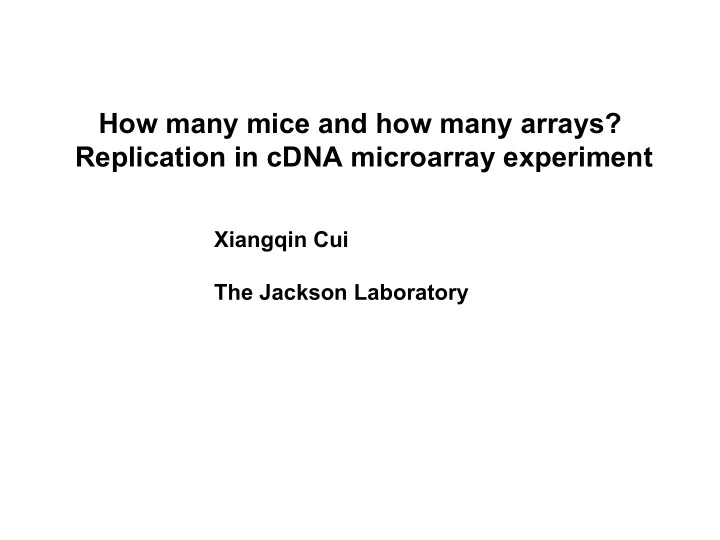

How many mice and how many arrays? Replication in cDNA microarray experiment Xiangqin Cui The Jackson Laboratory
Data preprocess: Download data Trim to 5507 clones in all organs Extract foreground only log 2 transformation Intensity-Lowess transformation Channel-mean center each channel Y Not log ratio ijk
Mixed linear model for each gene: Individual organ: = + + + + + ε y u M D A R ijk i j k ijk Log 2 (signal) Meas. error Dye effect Array effect σ 2 (random ) σ 2 Gene mean (fixed) (random ) e a (fixed) Reference mean Mouse effect σ 2 (fixed) (random ) m σ σ ε σ 2 2 2 M ~ N ( 0 , ) A ~ N ( 0 , ) ~ N ( 0 , ) Assumptions : ijk e i m k a = + + + + + + ε y u O M D A R Combined data: lijk l i j k lijk Organ (fixed effect)
Estimated variance components from kidney Significant gene
Estimated variance components from all organs
Variance components from two other data sets: Gallstone Brain cortex
MSE for treatment effects: Trt A Trt B Reference Design m1 m2 m3 m4 ( m = 2 ) ( n = 2 ) R R R R σ σ σ σ 2 2 2 2 = + + + MSE m a s e m mn mnr mnr m : number of mice per treatment n : number of arrays per mouse r: number of spots for each clone on array
Power at different fold changes 1.5 fold change 2 mice / trt, 2 arrays / mouse 2 mice / trt, 4 arrays / mouse 2 mice / trt, 6 arrays / mouse 4 mice / trt, 2 arrays / mouse 4 mice / trt, 4 arrays / mouse 4 mice / trt, 6 arrays / mouse kidney Log 2 (fold change)
Power to detect 1.5 fold change in kidney 2 mice / trt 4 mice / trt 6 mice / trt 8 mice / trt 32 24 16 12 8
Power to detect 1.5 fold change 2 mice / trt 4 mice / trt 6 mice / trt 8 mice / trt
Resource allocation: m mice / trt σ σ σ σ n arrays / mouse 2 2 2 2 = + + + m a s e MSE r spot replicates on array m mn mnr mnr C m cost / mouse C a cost / array = + ⋅ Cost mC m nC σ spot variation 2 m a s The optimum number of arrays per mouse: σ + σ + σ 2 2 2 r C = ⋅ a s e m n σ 2 r C m a
Examples for resource allocation • Based on the variance components estimated from Project Normal data. • r = 1 ( no replicated spots on array ) • Reference design Mouse price Array price # of arrays per mouse $15 $300 2 $300 $300 7 $1500 $300 16 More efficient array level designs, such as direct comparisons and loop designs, can reduce the optimum number of arrays per mouse.
Pooling mice Pooling can reduce the mouse variance but not the technical variances 1 σ = k σ 2 2 pool m α k : pool size α : constant for the effect of pooling. 0 < α < 1 α = 0, pooling has no effect. α = 1, pooling has maximum effect.
Power increase to detect 1.5 fold change by pooling ( Pool size k = 3, α = 1 ) 2 mice / trt 4 mice / trt 6 mice / trt 8 mice / trt 2 pools / trt 4 pools / trt 6 pools / trt 8 pools / trt
2 mice / trt 4 mice / trt 6 mice / trt 8 mice / trt 2 pools / trt 4 pools / trt 6 pools / trt 8 pools / trt
Conclusions * Technical variation is larger than biological variation for most genes. * Increase of technical replication can improve the power of the experiment effectively. * Biological replication is essential for making broad-sense inferences. Increase of it is more effective in improving the power of the experiment. * Pooling can reduce biological variation. However, the effect can be small due to relative small biological variation.
Acknowledgements: The Jackson Laboratory : Gary A. Churchill Hao Wu Qian Li Microarray facility Beverly J. Paigen TIGR: John Quackenbush
Recommend
More recommend